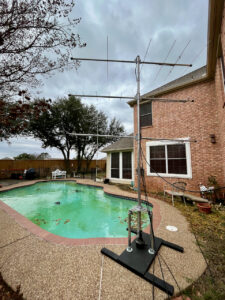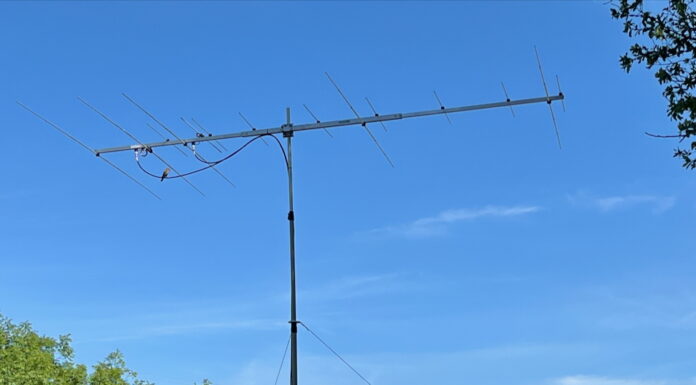The results were reasonably good, due for the most part to an excellent 6 meter Es opening on Saturday followed by nothing on Sunday, however. Here’s the scoresheet.
- 50 MHz, 189 QSOs, 79 multipliers
- 144 MHz, 43 QSOs, 11 multipliers
- 222 MHz, zilch due to equipment challenges
- 432 MHz, 13 QSOs, 8 multipliers
My total score was 24,794 points. All my QSOs were digital. Most were FT8 but a few on MSK144 and one on Q65.
Contest Setup and Troubleshooting
Daily I operate a 6 meter station, watching for Es openings and rare grid rovers. So that’s all ready to go. For the contest, I do monitor the power level to make sure I stay under the 200 watt limit for Single Op Low Power. I use an IC-9100 for transmit and Airspy with SDR-Console for receive, an Antennas-Amplifiers PTT/Preamp which separates the receive output, a TE Systems amplifier, and a Directive Systems 5-element Yagi on a 25 foot push up mast.
For the contest, I setup an IC-910H to handle 144 and 432. For 144 I have a 170 watt RF Concepts amplifier. The 222 setup is the IC-9100 handling the IF into a Q5 Signal Transverter and 100 watt RF Concepts amplifier. I run two instances of WSJT-X, one for each rig. This allows me to monitor 6 and 2 meters at the same time, and transmit at the same time. I use N3FJP’s VHF Contest Logger
The troubleshooting is almost always about getting the computer audio connections to working. That challenged me a bit on the original Thursday setup. But then it hit again at five minutes before contest start. No cuss words, but not particularly fun. I also had some intermittent connections with the rotator to controller, but eventually solved those. Plus, I didn’t have to crawl onto and into my car to get it done as is more typical before VHF contest roving.
Operation
The contest started with a band opening on 6 meters, see the chart below. There was a nice sporadic E opening to the east with a steady run of stations and lots of grids. Sunday, I could see an Es opening on the east coast but it didn’t make it here. So it was mostly watching diligently for new stations.
There was a bit of running the bands, but not much. I could see messages on 6 and 2 meters asking for 432. I followed and worked a couple that way. I also responded to phone calls from a rover and a portable station.
Unfortunately, when I tried to work 222, I found that the station control system wasn’t working. I didn’t really have time to troubleshoot during the contest. That’s something to look at this week. With changing patterns in VHF contests, I’m beginning to wonder if I need this band.
Overall, I spent 25 hours in front of the radio. My off-time was seven hours sleeping and stopping one hour early since nothing new was showing up. I’ll note, too, that early hour operations on Sunday morning were pretty slim pickings.
Antenna Brick Wall
 You can see from the nearby photo that I used the same mounting from my rover setup in the backyard. I also added another mast section to get a bit more height. Plus, since the 6 meter Yagi was on the push-up mast, I only needed to setup the next three bands on the mast.
You can see from the nearby photo that I used the same mounting from my rover setup in the backyard. I also added another mast section to get a bit more height. Plus, since the 6 meter Yagi was on the push-up mast, I only needed to setup the next three bands on the mast.
That setup worked well. Instead of running downstairs to turn the mast, like I do with 6 meters, I was able to use the rotator. Plus, the same 30 foot cables as I use in the rover, worked from the shack. The downside was that when I rotated the antennas to the west or northeast, they were pointing into a brick wall. So that was a handicap. But there are only a couple of stations in that direction.
Online Scoreboard
I’ve highlighted the Contest Online Scoreboard a few times. This time I spent a bit more time watching it, particularly during the lulls. At first AB8M and I were neck-and-neck in the contest. Believe me, that kept me in the chair much more than it would have without the system.
On Sunday, NF3R and N8XQM showed up and ran away with things. Of course, the system is only tracking the scores of those who connect their logs, which is pretty simple using N3FJP and I suppose N1MM. But it can be a motivator. Something to think about for your own operation.
I hope you had fun during the contest. I know I did. It has also been helpful in pointing out a few issues with my station, my operating, and where to go next. Thanks for your QSOs.
Results
I finished a respectable 11th in the USA. And not too bad locally. Plus, a couple of my photos made it into the final results article. Thanks to everyone for the QSOs.











You were not the only one watching the scoreboard closely. 🙂 73
Hi Doug, it was fun and gave me something to comment on with my wife when I grabbed coffee. I just wish we were too busy with pileups to look at the contest scoreboard! Maybe in June. 73 and I’ll be watching…
I wasn’t really available for the contest, but I did make a few QSOs on 146.52 and 446.0. Sunday night I added my one 23cm contact with the ham in the next town over that I always make the 23cm contact with.
Great work Joseph. Handing out a few contacts can be very helpful in the contest. Enter the right category, perhaps FM Only in your case, and you could actually win your area! 73, Jim